Clea Simon's Blog, page 16
March 30, 2021
Hear, hear! “A Cat on the Case” audiobook review
What’s better than having a story read to you? Especially by a pro like Hilary Huber? Thanks to Audible and other audiobook services, all my witch cats books are available as downloads and CDs. This week, Sandie Herron reviewed the audiobook of A Cat on the Case over at librarian Lesa Holstine’s Lesa’s Book Critiques, and quite enjoyed the “cacophony of voices and purrs,” especially the cats’ “wickedly smart and funny purr-sonalities.”
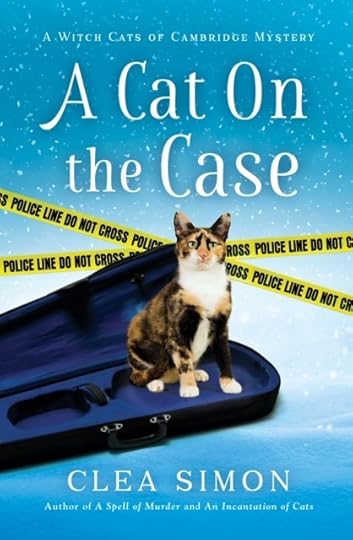
Here’s her review:
Becca Colwin believes she is a witch since, after all, she did conjure a pillow out of thin air. However, as she and her tiny coven knows, she hasn’t been able to do anything magical since then. Becca’s three cats, all littermates, easily talk among themselves about the timing of their summoning spell coinciding with Becca’s. It is Clara, Laurel, and Harriet that know better. These three have wickedly smart and funny purr-sonalities.
It is Becca’s neighbor that pounds on the door, complaining of the noise the cats were making. Becca’s building is converting to condos, and she is just meeting new neighbors. Becca recently started work at Charm and Cherish that keeps her away all day when the cats were accustomed to her 24 hour service. While at work, a woman rushes in, apparently looking for a witch detective, but she abruptly exits, leaving behind a violin case. Unable to catch her, Becca reviews the contents and finds a note with her apartment building’s address. She sprints home to try and return the case only to find the young woman struggling to open a neighbor’s door. The two women are startled to see a man dead on the floor.
The mystery woman is Ruby, a woman who has come to Boston to audition for a place in the Conservatory. The dead man was renting her a place to stay for a few days. Becca spends the next few days trying to understand Ruby’s story about her cherished violin. It was an heirloom in her family, much loved, much played. A friend offered to buy it in order to finance her trip to Boston and replace it with an ordinary violin. But Ruby swears the original violin returned. The police tell Becca it was stolen from a collector.
Through a series of fits and starts, Becca and Ruby keep running into each other, sometimes on purpose, sometimes not. Strange things keep happening to Becca’s friends, her apartment is ransacked, and her job at Charm and Cherish is threatened. All the while Becca’s three cats continue to narrate every move because the youngest, Clara, is constantly with her beloved human, even if she is “shaded.”
Hillary Huber did an excellent job of telling the story from her point of view as the narrator, and she also alternately portrayed all three cats narrating the story. There always seemed to be a conversation going on about the action. At the same time, Clara was learning a bit of her history as a cat in dreams directed by her sisters. I chuckled often over the cat-like traits described by the cats and differently by their human. There was often a cacophony of voices and purrs going on.
Finally, Ruby tells Becca the full truth about the violin, as she knows it. But Becca has learned more, and the two find themselves on the run in the middle of blizzard with Clara chasing after them. Everything comes together in the end, but not at all how I expected.
A Cat on the Case by Clea Simon. Polis Books, 2021. ISBN 9781951709266 (hardcover), 320p.
Written by Clea Simon
Narrated by Hillary Huber
Series: Witch Cats of Cambridge, Book 3
Unabridged Audiobook
Dreamscape Media (2/8/2021)
Listening Length: 8 hours 29 minutes
:
Virtual book tour visit from Judy Copek
Hi everyone! It’s been a while! But in the interim, I’ve finished the first draft of a standalone WIP (more about that sometime later) and I’ve gotten my first vaccine! Yay! But the world moves on, and that includes new books by friends and colleagues. Today, I’m happy to host Judy Copek, who (along with husband Hans) is a stalwart of the New England crime fiction scene. She’s celebrating her fifth mystery, Murder in the North Woods, and she’s here to talk about how this particular book came to be.
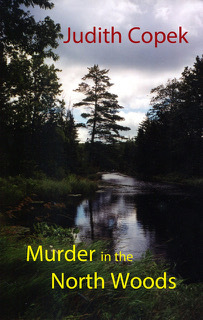
Murder in the North Woods: an amateur sleuth mystery. Actually, a reluctant sleuth mystery.
Years ago, when my husband and I dropped our two sons off at a scout camp in Wisconsin, I had no clue it would inspire a book. I was a young mom, not a writer.
When I found myself on a Y2K team to bring old software into the new century, I had no idea this difficult project would also inspire a book. But by then I was a writer.
I had no foreshadowing that my best friend from college would become a character in my book.
You go through life accumulating people and places and experiences, and something clicks, and you think, “I believe there’s a book there.” And so it was that with my profession in technology (at a shoe company) and my memories of the camp and little towns In the North Woods, and my wanting to put my friend when all her eccentricities into a novel, that I decided to write what became Murder In the North Woods.
My kids were grown (although one still trekked back to the camp for worker weekends). He had risen from camper to counsellor, to managing the food service to working with the Wilderness Engineers. He had a lot of stories and many of them were funny. They inspired me, but they are not in the book. They inform the book.

Writers know that conflict drives the plot. A must-not-fail project with know-it-all consultants and a sullen work force has major conflict A woman torn between her boyfriend and her husband is conflict to the max. My main character, Laura Goode, is so relieved to get a consulting gig away from home in a quiet town where she can think long and hard about her dilemma. But when she arrives in Wisconsin’s North Woods, Laura discovers her only contact is now a corpse. The information officer at Great Northern Shoe Company was a local lothario whose killer could be anyone from an enraged husband to a bitter factory worker whose job is heading overseas. Laura is in trouble from day one.
Judy was born in Montana, raised in Colorado, educated in Texas, and lived in suburban Chicago for years and now even more years in suburban Boston where she became a Red Sox fan, a Patriots fan, and a writer. An information systems nerd for years, she likes to show technology’s humor and quirkiness along with its scary aspects.
Murder in the Northwoods is her fifth published novel. The research trip to the area was one of the best vacations ever, she says, “with scenery, casinos, bars, intriguing discoveries, and tasty North Woods food. I never make up anything that I can borrow from real life like the garage apartment, the character of Reverend Josie, and the cottage by the lake. I moved some of the geography of Newton, Kansas to the fictional town of DuBois. Writers do strange things to create believable fiction. Y2K (remember the Millennium Bug?) pulls many of the story elements together, as I had worked on a project like the one on the book. My project, of course, had no murders and much less sex. Well, none. Characters misbehaving are fun to write and fun to read.”
Find Murder in the North Woods through all the usual outlets.
Find Judy on social media at:
Facebook: https://www.facebook.com/JudithCopek/
Twitter: https://twitter.com/judyinboston
Instagram: https://www.instagram.com/judyinboston/
Blog: http://lynx-sis.blogspot.com/
Website: www.judycopek.com
March 26, 2021
The magic of cats … and a giveaway
I wrote about cat magic for Kings River Life this week – and we included a giveaway! You’ve got to click through to enter, but here’s a teaser:
Sometimes, the lack of a reaction tells you more than any startled gasp ever could. That’s what I’m realizing now that my A Cat on the Case, the third Witch Cat of Cambridge cozy mystery, makes its way to readers. The big shock? Cat people aren’t surprised by the idea that cats have magical powers. It’s as if they already knew.
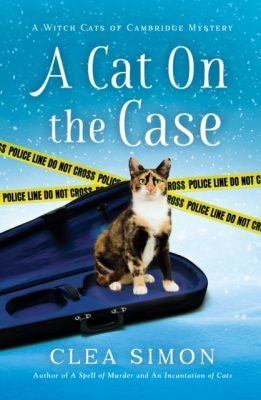
Granted, the magic that the three cats in my books can perform has its limits. Harriet, the eldest of the three littermates and a big orange puffball of a feline, can “summon” objects out of the air. Laurel, the middle sister who takes after Siamese ancestors, influences humans with the power of suggestion. And Clara, the baby and the one most devoted to their human, Becca, can both “shade” herself into invisibility and pass through solid objects, like doors. (She secretly suspects that this might have to do with her calico spots, but I’m not telling.) And while some critics have scoffed at these powers, cat people by and large have accepted them without question.
This might not exactly be the case of “the dog that didn’t bark” which famously alerted Sherlock Holmes in “Silver Blaze”, but, to this writer, it’s just as telling. We humans have long viewed our feline companions as magical – or at least possessing powers beyond those of catching vermin or warming our laps on a cold night.
Some of this we all know. Cats, for example, are the most frequently cited “familiars” – or magical helpers – of witches in our folklore. And spooky stories from Edgar Allen Poe on down have told of “cat queens” who inherit mystical realms or possess psychic powers. When I was researching my nonfiction book The Feline Mystique: On the Mysterious Connection Between Women and Cats, I found that this linkage goes back millennia. The ancient Egyptians, for example, attributed divine powers to both women and cats; the cat-headed goddess Bastet (or Bast) had responsibilities that included controlling the flooding of the Nile as well as the brewing of beer, while the Norse goddess Freya scooped up fallen warriors in a chariot pulled by flying cats. The Hindu goddess Durga is linked to cats as well – specifically big cats, as she rides a lion into battle, while in South America, the divinity Tezcatlipoca often takes the form of a jaguar.
The sources of this global phenomenon are more elusive. Some of it may be as simple as cats’ innate grace. With their flexible bodies and excellent night vision, our feline companions often seem able to defy death, slipping away into darkness and reappearing again. The fact that they helped our ancestors survive, by protecting our harvests, gave them an added boost, as did their fertility and the apparent ease with which they birth multiple litters (all the more reason to spay or neuter your pet now!).
Of course, cats’ magic could also be in the way they draw us in, mesmerizing us with their beauty and playfulness. Could our favorite housecats be capable of more? Could they, in fact, be helping us live our lives – and solve our cases? Having been lucky enough to make the acquaintance of Clara, Laurel, and Harriet, I wouldn’t be surprised.
To enter: https://kingsriverlife.com/03/24/the-magic-of-cats/
February 24, 2021
“The Inside Job,” a short story
Hi folks! This story was published in Masthead: Best New England Crime Stories, an anthology just packed with goodies! I recommend picking up a copy (your local library might have it). But I’m reprinting my own contributions, “The Inside Job,” below:
The Inside Job
By Clea Simon
Carefully, carefully, her fingers trembling, she tilted the jar. Lifted the square of cardboard that had blocked the top and watched as the mouse slid out onto the bare ground by the stoop. For a moment it stood there, black eyes wide and whiskers trembling, and then it took off, tawny back disappearing into the dried grass. Eager, it seemed, to be free, despite the growing chill. The coming winter. Maybe it would find another shelter, another kitchen to haunt. Maybe not, but she had done what she could.
She stepped back, closing the glass storm door with a shudder of relief. The innocent creature had been set free. She was safe inside.
Thoughts of the mouse running through the yard, burrowing into a hillock of grass or eating the fall from her neighbor’s bird feeder preoccupied her as she washed the jar. She enjoyed such fantasies—a wild thing, running through the wild—and silently thanked the therapist who had suggested them, as she set the jar aside to dry. He had called it “desensitizing,” a term she smiled at now. It didn’t matter. Even before disability stopped paying his bills, she had ended the weekly calls. It was better to accept reality. Her reality. Inside.
It wasn’t like she was out of touch with the outside world, not at all. If anything, she was more connected now in this, her second life. As she took her tea over to the kitchen table, she mulled the apparent contradiction.
She had never been one for newspapers. That had been Hugh’s thing, reading from the front page through the obits, saving sports for last. Especially once he’d retired, he’d devoured the news—not just the city daily but the Journal, the local weekly, with its tales of neighborhood crimes and heroes.
She’d kept the subscriptions after Hugh passed. Not from the virus, thank God, but gone these four years nonetheless. Now she found them a comforting part of her morning ritual, a connection with the world outside. At first, she’d seen them as a first step—the exercise of retrieving them from the stoop a test of her nerve. The virus had passed by then, but after the months in quarantine, she’d still found herself disinclined to venture out. “Disinclined”—her therapist had had issues with that word. “Afraid,” then, but with delivery services easing up since the pandemic, she really didn’t see any reason to push herself. When the paper missed the stoop, she let it be. The town, her neighbors… someone picked them up eventually.
Thinking of Hugh, she made herself start with the paper’s top story. A shooting death, it wouldn’t have been her first choice for breakfast reading. But the headline had been misleading, she realized a few paragraphs in. This was a continuation of a report she had been quite absorbed in only a few days earlier. Then, it was about a break-in, a kind of crime that she found particularly threatening even though it had been at a store—a well-known jeweler’s—and not a private home. Still, she’d been grateful to read that initial reports indicated an inside job—a guard had been seen taking pictures of the security system. A former police officer, he’d been injured when the robbery had gone awry, and so questioning had been delayed. In the week since the last Journal had been published he had died, but the police had another suspect in custody for what was now a murder charge.
“Hugh, you wouldn’t recognize the neighborhood.” She knew he wasn’t there but speaking to him helped her air her thoughts. “A homeless man, no less. After what they went through during the virus, maybe it’s no surprise.”
The suspect, a former Army vet, was described as proficient with weapons, though no gun had been found. And unlike the poor sad souls who so frequently couldn’t string a coherent sentence together, this one had made a statement. “The suspect, Edward Worrell, 58, said he had not intended any harm. ‘I didn’t know there’d be a guard,’ Worrell had told the investigating officers.”
Evil? Understandable? Whatever the intent, the result had been diabolical. Breaking her own rule, she pushed the paper away. She imagined Hugh chiding her, pointing out all the stories unread. But she’d finished her coffee, and she needed to take a break. Just because she was a shut-in did not mean she couldn’t exercise, and she’d been good about her 10,000 steps. Most days, anyway, and right now some physical activity was what she needed.
Today she took her favorite “walk,” heading into the town center via the hallway and, for variety’s sake, around the kitchen. Keeping up a brisk pace, she visualized the houses as she remembered them. The neighbor’s yew, its berries red as the cold came on. The holly that had taken over the corner. Although the slight hill that led to the high street wasn’t anything like the stairs, she started up them as well, feeling her breathing quicken.
“There’s the bakery, Hugh. The one where we used to get the babka. In good weather, they put tables outside now, and they sell the babka by the slice.” A trainer had told her that as long as she could speak, she wasn’t pushing herself too hard. Besides, it made the “stroll” more fun. Having come back down, she decided to start back up again and then stopped herself. It wasn’t the exertion, though she had begun to perspire. It was the memory. “No, let’s not walk down Somerville Avenue today,” she said to her late husband. “Something happened there. I’ll tell you tomorrow.”
The next morning she had only the daily to deal with. A bigger paper, but, in a way, a relief. International news and then a story about city finances. The only mention of the local crime was in the Metro section, a tiny item stating what she already knew: that there had been a shooting but that a suspect was in custody. An investigation was ongoing.
The next day—or maybe it was two—she’d seen another mention of the investigation but allowed herself to skip over it. Surely, by this point, it was a formality. By the end of the week, she had nearly forgotten about the case. She’d even taken to “walking” by the jeweler’s again. Hugh had always liked that street, with its ancient maples. Toward the end, she’d been cautious about walking it with him—the tree roots buckled the sidewalk in places, making the footing treacherous. In the privacy of her own home, such concerns didn’t matter, and as the autumn progressed, she could enjoy the changing colors of those plentiful, broad leaves. In her memory, anyway.
When she sat down with the next edition of the Journal, she was ready. She’d been weak to stop reading, and, really, she couldn’t allow herself to let anything else go. Luckily, the shooting story was no longer on the front page. But after two pages of city taxes, she was grateful to find the Crime Blotter. “Witness comes forward,” she read with interest. The new report revealed that the witness, a retired policeman, had just emerged from the T stop at the time of the crime, and chance had prompted him to glance at the jewelry shop across the street. Until he’d heard the noise, the former Officer Stewart Laskow hadn’t thought anything of what he saw through the jeweler’s big front window—two men apparently in close conversation inside the small shop. Only when he’d heard the shot and seen someone run out had he realized what was happening. He’d immediately called the local precinct and run to help the victim, doing CPR and accompanying him to the hospital.
“How horrible.” She could picture the street, the storefront, so clearly. It all seemed too close to home. No wonder she never wanted to go outside.
The story then recapped the details of the crime. A robbery gone bad. False leads, and finally the arrest of an indigent man known for sleeping in the alley by the T station. It was the picture of the suspect at his arraignment that had sparked the witness’s memory. That, and his statement.
“‘I hadn’t seen the guard when I went in,’ the suspect had told the investigators. The witness contested…”
She paused mid-sentence, taken aback. “He hadn’t seen…” Was that right? She thought she’d had the details down. The man’s name—Worrell—the shop, the victim. Was she misremembering? Or worse?
“No one ever thinks they’re losing it, Helen.” Hugh’s voice. She could picture the smile that had softened his frank words. “That’s why we need other people, sometimes. A community.”
A community. Well, she didn’t have that. But she did have other means of confirming her memory, if not her sanity.
Steeling herself, she walked up to her front door and took a breath. A deep one, and let it out slowly, through her nose. Then, before she could lose her nerve, she pulled the door open and stepped out on the stoop. The stack of newspapers she had tied so neatly, by way of an apology to the sanitation workers, was still there, and she pulled it back in, slamming the door behind her. Her hands still shaking, she fumbled with the knot and then gave in, cutting the twine to extract the previous week’s Journal.
Page one, she skimmed down. A robbery gone bad. A new lead, and an arrest. Edward Worrell, homeless. “I didn’t know there’d be a guard.” How strange, and yet how reassuring. Her memory had been correct. The original statement had been reported as slightly different in the more recent issue. “I didn’t know…” had become “I hadn’t seen.”
The shift was subtle. A correction of an earlier misreporting, perhaps. Or a story clarified under questioning. Unless…
She went back to the new report. The witness said he’d been across the street—over by the T station—when he had seen the suspect through the window. She knew that station, that window. She had walked down that very street the previous afternoon. Hugh would back her…
No. She stopped herself. She had not walked down it. She had imagined walking down it. Pretended. And Hugh was not around to support any tale she had to tell. Not anymore.
“Don’t be crazy, Helen.” Unbidden, his voice came to her. “Not any crazier than you already are.”
“You’re right, Hugh.” She spoke the words out loud. Habit. “I really don’t need any more challenges to my sanity.”
She made herself move on. Through the shopping news. A poorly written review of a local play, no doubt no better constructed than the dramatic production itself. She shook her head. Once, she had considered herself an intellectual. “A smart cookie,” Hugh had called her. And now here she was. Locked in her house and reading second-rate criticism.
Still, there was rigor in discipline. She made herself continue. Through the sports and the obits. A tribute to the guard who had been killed. Lucas Steinman, a former police patrolman, he had retired in the wake of an investigation. He’d been cleared, the community liaison had stated, and he still had many friends on the force. “In uniform or out, Lucas Steinman was an asset to the community,” the statement read. “He will be missed.”
Lucas Steinman. She wrote it down: the victim now had a name. A story. On a whim, she jotted down the name of the liaison as well. When she finally finished the paper, she made herself wash the breakfast dishes and water the plants. The geranium needed pruning, which she did with care and circumspection, rotating the plant to change its exposure to the sun. Only then did she allow herself the indulgence of a Google search. The community liaison and the dead man, Steinman. It was a relief when the day’s article popped up, and nothing more. Still, she had the time. She typed in the name of the witness: Laskow. Yes, he had served with the dead man. No wonder he had run toward him. It hit her then how horrible that must have been. The shock. He’d been a friend. Laskow’s name came up in connection with that earlier investigation as well, once in a series of articles. She read them through to confirm that, yes, all the charges had been dropped.
That day, when she went for her “walk,” she found herself strolling down the avenue again. As she tried to convince herself her choice was random, she burst out laughing. She was intrigued, and she should admit it. Yes, she was probably making a mountain out of a molehill. She was amusing herself. Picturing the scene, without the shooting, of course. It would do her no good to imagine carnage.
That night, she dreamt of trees—big shade maples casting shadows on a plate-glass window—and woke thinking of her geranium. How it strained toward the fading autumn sun. When she woke, she told herself she was being silly. The maples might no longer be there. The sun might not be as angled as she imagined.
“Only one way to find out.” Hugh, the voice of reason. “You’re a smart cookie.”
Breaking her own rule, she booted up the computer, even before taking the paper in. Google earth confirmed that the trees were still there, at least as recently as September.
And the sun? She went back to the original crime report, which she had left on the kitchen table. The robbery had happened on September 22, a little after five p.m., shortly before the store would ordinarily close. The store was on the east side of the street, and at that hour, that time of year, the sun would have been sinking already. She could picture the light streaming through that big alley by the T station, the one where the homeless man had slept. Yes, those big maples would block some of it, but the glancing light on the windows…
She shook her head. This wasn’t some jigsaw puzzle, a pastime to make the days go by. So he had looked across the street and into the window. Maybe there was a patch of shade. Maybe he wanted to see his friend. She imagined a presentiment of danger. Of fear.
Only, why hadn’t Laskow mentioned knowing Steinman when he talked to the reporter? That the man he found, wounded on the floor of the shop, had been a colleague? Maybe he had, she told herself. Newspapers have limited space; reporters don’t use everything they’re told.
The next morning, she grabbed the daily from the stoop almost without thought, looking for a further report. When she found none, she left the paper open on the kitchen table and took her tea to the computer. Yes, other news outlets had covered the story. Yes, she realized, there were discrepancies, particularly in Worrell’s statement as it had originally been reported and how it was more recently presented.
There were many possible reasons for this, she told herself as she sipped tea that had gone cold. Perhaps the original phrasing had been a result of sloppy reporting. She searched for a clarification, some note correcting the earlier article. Just because she could not find one didn’t mean that one hadn’t run, perhaps in a print edition. Newspapers, she knew, erred on the side of caution, but nobody liked their mistakes to be bruited about. Likely, the new version had been vetted. Issued by the police as the case wound to a close. But since this new statement wasn’t qualified—wasn’t linked to new evidence and didn’t cite new interviews—she had to wonder: were the police somehow involved? The deceased had been an officer, even if he had left the force. Which led to another thought, one that even a brisk walk around kitchen could not resolve. Was an innocent man being railroaded?
It was a puzzle, she told herself, as she headed toward the stairs. Only with too many pieces missing. If only she had some way of having her questions answered. A source that didn’t raise more questions along the way.
She dismissed the urge to race to the phone. The local precinct had already done more than enough for her, answering her calls during those first bad days when every noise spooked her. Besides, if the police were somehow involved in a coverup. Or something worse…
The gravity of it made her freeze. She grabbed the bannister.
If she could only reach the man himself. Or someone who could speak for him. If only he had a liaison, like the police did.
“Come on, Helen. You’re smarter than that.”
The suspect was homeless. However, he had to have a lawyer—a public defender. But who? She thought of her computer, back downstairs, but after a moment continued her ascent and turned instead toward the bedroom, where she picked up the phone. A landline, it served as her panic button in those first bad days. More recently she treasured it for giving her access to the city’s 3-1-1 service. For once, she wasn’t calling about a city function, however. Asking for an exemption to taking her trash to the curb or for clearing the snow from the walk.
“Hello? I’m wondering how I can reach the public defender working with Edward Worrell.”
There was some confusion, but soon enough the young woman on the line caught on. Such things were in the public record, and Helen told herself the operator was grateful for the challenge. For a search that didn’t involve street cleaning or rats. She came away with a name, Bernie Kraus. He worked with the city’s legal aid clinic.
Helen had grown skilled at reading voices. This one was young—and tired. She introduced herself and proceeded right to the point.
“I have information that may clear your client.”
“You do?” Skeptical, of course. She expected that.
“I do. I know the area well, and there’s no way the witness could have seen into the store. Not at that time of day, with the shadows from the trees and the late afternoon sun reflecting off the window.”
“That’s great.” A young lawyer, she was sure. Grateful for anything that he could use. “When can you come in?”
“Oh, I can’t.” Momentarily taken aback. “I haven’t been out since the virus. But–”
Too late. He had hung up.
How rude! A brief flare of anger surged through her, and she sat heavily on the bed, feeling disappointment like a blow. Well, if he didn’t care enough about his client to give her two minutes of his time, why should she care?
“Because he’s not the one who’s locked up.” Hugh’s voice, the voice of reason. “He’s not the one you’re trying to help.”
“You’re right, Hugh.” She pushed herself up and headed back down to the computer, a plan already forming. “As always.”
Two hours later, she had the package assembled. Screen shots of street views. An item from a meteorological site, chronicling the increasingly oblique angle of the sun as the autumn progressed. The history she’d dug up, the connections between the dead guard and the so-called witness. Those news reports, the shifting statements highlighted and bold. As she hadn’t been able to do on the phone, she explained what everything meant—what it implied, anyway—in a letter.
…In conclusion, she wrote, a thorough re-examination of both the statements and the evidence suggests that not only is Mr. Worrell innocent of the crime but that Mr. Laskow, the purported witness, should be investigated. Not only is one man dead, but a vulnerable person has been implicated, wrongfully and with malice. These evils must not be let stand.
There she paused. If she signed it with her own name, would the young public defender dismiss the package without examining its contents? After a few moments of thought, she decided she would play into the system, falling back on a form she hadn’t used in years.
Sincerely,
Mrs. Hugh Clevin
Briefly, she thought about printing it all out. She had envelopes, and the postal service regularly brought her a lovely assortment of stamps. But then she was struck by a vision of the lawyer’s desk, piled high with papers. Mr. Worrell, sitting in a cell.
A smart cookie, Hugh had always said, and it took only minutes to create a zip file—a folder big enough to hold everything. To make certain the file went through, she cc’d herself—and the director of the legal aid clinic as well. And with a dramatic flourish of the wrist, she hit “send.”
Within a week, the story was on the front page again. The investigation had been re-opened. The state had gotten involved. A front-page photo of Mr. Worrell leaving the courthouse, a free man. Eyes wide with wonder.
When the public defender called, three days later, she was surprised. She had missed the puzzle aspect, of course. But her role, she had figured, was done.
Indeed it was, the lawyer said. He had reached out merely to fill her in. It was her work, after all, that had freed his client, helping to prove him an innocent man. “Invaluable and dogged,” he called her efforts. That’s why he wanted her to know what was happening next.
“Next?” She pictured that mouse, quivering on the edge of freedom.
“Yes,” the young man said. “We are a community. We have a responsibility to each other.”
Worrell, he reminded her, was a veteran. That made him eligible for various benefits that he had never accessed. She blinked away the tears as he described the programs available. Counseling services. Vouchers. A second chance.
“I know it’s to avoid a suit, but the police community relations officer has really stepped up. She’s taking him around to look at apartments today.” He paused. This was hard for him, she could tell. “I’m sorry I doubted you. Thank you.”
“No,” she replied, her voice thick. Community. She could hear him still. “Thank Hugh.”
“The Inside Job” was published in Masthead: Best New England Crime Stories (Level Best Books) on Dec. 15,2020.
###
February 13, 2021
Hardcover A CAT ON THE CASE!
They’re here! The hardcover edition of A CAT ON THE CASE just showed up at my house, which means that it should be in stores and online soon. What’s a couple of weeks to a cat, anyway? Isn’t this the perfect Valentine?
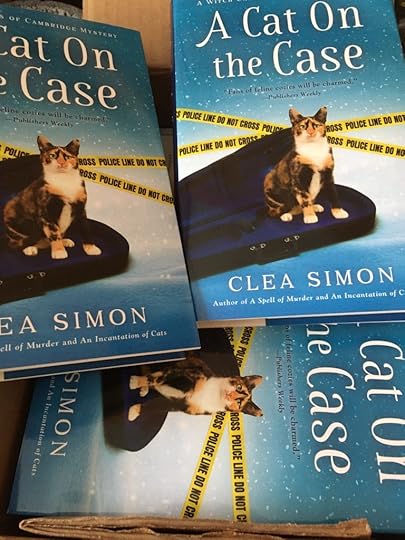
And doesn’t Thisbe look cozy with it? Sometimes a real, printed book is best.
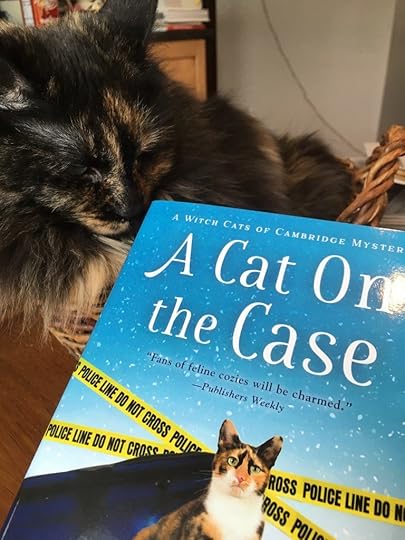
 [image error]
[image error]
February 9, 2021
Announcing HOLD ME DOWN
My next psychological suspense is now available for pre-order! HOLD ME DOWN will be published by Polis Books on Oct. 5.
Here’s the description: A riveting work of dark suspense from acclaimed author Clea Simon Gal, a middle-aged musician, is back in Boston to play a memorial for her late drummer/best friend, when she finds herself freezing on stage at the sight of a face in the crowd. The next day, she learns that the man she saw has been killed – beaten to death behind the venue – and her friend’s widower is being charged in connection with his death. When the friend refuses to defend himself, Gal wonders why and, as the memories of begin to flood back, she starts her own informal investigation. As she does so, she must reexamine her own wild life, her perception of the past, and an industry that monetizes dysfunction in a dark tale of love, music, and murder.
HOLD ME DOWN is a standalone novel of suspense, set in the basement clubs and dark back rooms behind the stage lights of rock and roll stardom. Like 2017’s Massachusetts Book Awards “must read” World Enough, HOLD ME DOWN deals with love in all its forms, community, and rock and roll from a strong, if damaged female perspective.
Coming from Polis Books Oct. 5, 2021
“A hard-rocking riff of a novel, HOLD ME DOWN explodes with a passion for music while also probing the intimate betrayals buried under a haze of alcohol and pills. Simon tells her story from the perspective of an aging female star trying to understand where it all went wrong, expertly exploring how music seeks to embody truth, even when musicians hid their own pain behind the melodies.” – Joanna Schaffhausen, winner of the 2016 MWA/St. Martin’s Minotaur first crime novel award for The Vanishing Season“Clea Simon’s devastatingly powerful mystery hits you like a punch in the heart. About aging, regret, and women in rock and roll, it’s also about how no matter how hard you fight, some things are never behind you, be it deep love or a terrifyingly brutal assault, and that survival doesn’t always look like what you think it does. Gripping, truthful and provocative.” – Caroline Leavitt, New York Times bestselling author of Pictures of You and Is this Tomorrow
“HOLD ME DOWN is powerfully written and compulsively readable. Part murder mystery and part wistful history of a one-time rock star and her deeply buried secrets.”– Dave Zeltserman, award-winning author of over 20 crime, thriller, and horror novels, including Small Crimes, now a Netflix film
February 7, 2021
Welcoming Eileen Watkins – more cat cozies!
Back in the days when we could mingle freely, Eileen Watkins and I often crossed paths. Her cat cozies are great fun and (like mine) draw on real cats for inspiration. So when I heard she had a new book out, CLAW & DISORDER,I knew I wanted to share the news.
PUSHING THE “COZY” BOUNDARIES
By Eileen Watkins
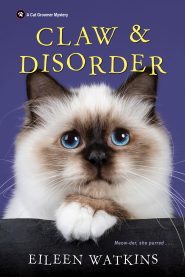
It might surprise people familiar with my current Cat Groomer Mystery series to find out that I started out writing fairly gritty paranormal thrillers. I transitioned through two cozier paranormal mysteries before taking on my current series. But I still find myself a little bored by a “cozy” in which nothing very shocking happens, and there’s no real threat to the sleuth or anyone she cares very much about. I can’t shake the conviction that a murder mystery should still be at least a little scary!
Many such plots revolve not only around one very “safe” location and the protagonist’s immediate family and social circle. I can’t help feeling this strains credibility, because while anyone could be unlucky enough to have one murder occur in their normal, sane family or their quiet, respectable neighborhood, what are the odds of that happening again and again?
My series has been called realistic, and I don’t think that’s just because of the details I include about felines. Cassie’s job grooming and boarding cats brings her in contact with a wide range of people, so the felons are usually folks she hasn’t dealt with before and probably won’t encounter again (some will be behind bars). And being both smart and desperate, they place her in some life-threatening situations. Cassie escapes through her wits, but also because she maintains a convenient friendship with her town’s female police detective. Reviewers also have expressed relief that Cassie is not dating anyone in law enforcement, and that my books do not make the local cops look like idiots. Her main advantages are that she can mingle in different situations, keeping her eyes and ears open, and that people may confide in her more readily than in the police.
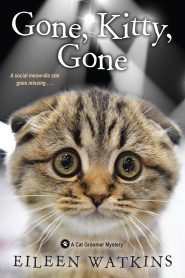
I’m pretty comfortable with the cozy boundaries for sex, violence and bad language. Cassie develops a relationship with the hunky local vet, and it’s implied that he stays over at her place or vice versa a couple of times a week, but the are no sex scenes. Some deaths are violent, but if they were gory we don’t see the bodies. I let a “hell” or a “damn” slip sometimes, most often when a male character is pushed to his limit, but if a villain blows his top I’m happy just to say that he “let fly a string of expletives.”
Finally, I believe that murders in real life usually occur when there’s something big at stake. Cozy writers are sometimes advised to kill off only mean characters, but I feel there’s greater motivation to solve the crime and get justice for a likeable character. The killer also appears more evil if he bumped off some innocent person who just got in the way. I’ve had likeable victims targeted for the political beliefs, because they knew too much, or just because they were in the wrong place at the wrong time.
I sometimes also tackle “disturbing” topics, such as a stalker obsessed with a pop singer or party drugs circulating in a suburban town. In my newest book, CLAW & DISORDER, I deal with two households where the owners have “material” issues—an elderly, ailing pair of hoarders, and a wealthy lady whose perfectionism is driving everyone around her insane.
It’s a good thing Cassie majored in Psychology in college and can stay one step ahead of them! The best thing about writing a cozy is that you can make everything come out (more or less) right in the end.
Eileen Watkins writes the Cat Groomer Mysteries, including The Persian Always Meows Twice, The Bengal Identity,Feral Attraction, Gone, Kitty, Gone and Claw & Disorder, for Kensington Publishing. The first four all have received Certificates of Excellence from the national Cat Writers’ Association. She previously published eight stand-alone mystery and suspense novels with Amber Quill Press, several of which won EPIC and Indie book awards in the Paranormal category. Eileen worked for daily newspapers for most of her career, writing and editing stories on fine art, architecture, interior design and home improvement. A confirmed “Jersey Girl” and animal lover, she has always shared her home with at least one cat and makes regular visits to the nearest riding stable. She is a member of Sisters in Crime and Mystery Writers of America. Visit her online at www.efwatkins.com.
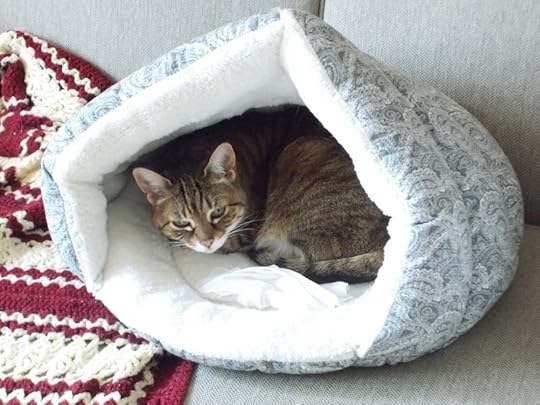
February 4, 2021
A Sisters in Crime Q&A
Sisters in Crime is a wonderful and welcoming organization for writers of all genders, published or not-yet. Among its many functions, this international organization introduces us to each other. Here’s a brief interview I did with my local chapter, Sisters in Crime New England. Feel free to post your own questions either below or (preferably) on the SinCNE blog!
Q&A: Clea Simon, A CAT ON THE CASEBy Kathryn Gandek-Tighe

Clea Simon updates us on her newest Witch Cats of Cambridge Mystery that was just released!
Writers usually hate writing book summaries. Will you share with us your real book blurb or one you wish you could have used?
The holidays are over. Winter is here and it’s horrible. Don’t you want to escape with some magical cats for a while?
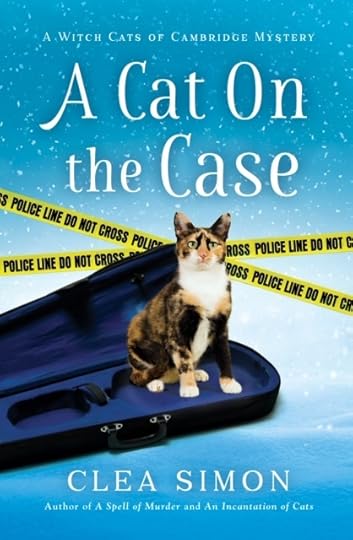
What was the a-ha moment that made you write this story?
I don’t want to give too much away, but I spent a lot of time thinking through my plot. I really wanted an engaging and complicated plot – but I wanted it to make sense, too. For that, it had to involve my human heroine but also had to engage both the feline senses and the magical powers of my three witch cats. I was out taking a walk one day, talking the story over with my husband, and he asked me one simple question and – a-ha! I realized that there was a simple switch that would make everything work. You could say it was my “dog that didn’t bark” moment. Only the book has no dog. And the cats don’t bark either.
What excited you most about writing this story?
I really love my characters. I love Becca and Clara, her devoted calico cat. But I also love Clara’s two littermates – the two other cats, who can be very annoying but who really have good points to make (and important roles in the plot). Plus, I’ve come to rely on Becca’s friend Maddy. She’s the voice of reason in Becca’s life. We all wish she’d have a little more faith in Becca, but really, she sees the world for what it is.
Which of your skill sets were useful constructing the plot?
I really got to draw on some diverse skill sets for A CAT ON THE CASE. My experience with Wicca – both reading a ton and also participating, for a while, in a Wiccan circle – is crucial to the series. But for this book, I also got to draw on my background as a musician. I’m a bass player, and I played string bass in community orchestras for years. Plus, my husband picked up violin as an adult, so that got to take me back. Thinking about playing, having instruments in the house to examine and refer to, and revisiting those years gave me the character of Ruby, the foreign student, who is at the center of this case.
What meal and drink do you think would pair well with your book?
This is definitely a hot cocoa kind of book! But because we’re all adults here, I wouldn’t complain if you jazzed up that cocoa with a shot of Grand Marnier. Something cozy that you can sip while reading, but with a little mystery and magic, too!
A former journalist, Clea Simon is the Boston Globe-bestselling author of nearly 30 mysteries. These alternate between cozies like her new A Cat on the Case, the third witch cat of Cambridge mystery, and darker psychological suspense, (Hold Me Down, coming Oct. 5). She can be reached at www.cleasimon.com
February 3, 2021
Thank you, WICKEDS! (And a giveaway)
How lovely to guest blog over at WICKED AUTHORS today. The Wickeds are a wonderful sisterhood of cozy writers, Liz Mugavero (Cate Conte), Sherry Harris, Jessie Crockett, J.A. Hennrikus (Julia Henry/Julianne Holmes), Edith Maxwell (Maddie Day), and Barbara Ross, who hosted me. Cruise on over and check out their latest – always fun! Or read my guest blog for a chance to win a copy of A CAT ON THE CASE.
When we read, especially cozies, we enter anothe, better world. Sometimes, I’m finding, that world is one that once existed – and maybe one day can again…. (read more here: https://wickedauthors.com/2021/02/02/author-clea-simon-on-the-case-and-a-giveaway/
January 27, 2021
Bristol Library raves about A CAT ON THE CASE
“Put a little magic back int o your life with the Witch Cats of Cambridge,” says the Bookblog of the Bristol Library. What a wonderful sentiment – I am overjoyed! Read the review here or below.
Friday, January 15, 2021A Cat on the Case by Clea Simon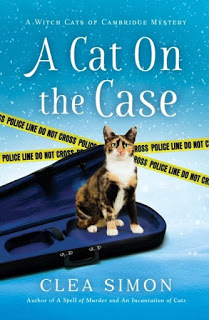
Reviewed by Jeanne
Becca Corwin, aspiring witch, has a day job at the Charm and Cherish, a New Age shop in Cambridge. Becca has offered her services as a detective, but so far there have been no takers even though she has had some success in the past.
But, unbeknownst to Becca, those successes were actually due to her three cats who—unlike Becca—actually do have powers. In fact, it was due to fluffy orange Harriet that Becca came to believe she had power after the luxury-loving feline conjured a pillow. Haughty Siamese Laurel believes that Becca should just spend her days looking after her cats, and possibly find a boyfriend. Our protagonist, loving calico Clara, is the one who worries about her person and tries to help out despite the snippy comments from her sisters. Clara has taken to surreptitiously following Becca to work, using her power to (mostly) hide her presence.
This day, a young woman comes into the shop asking about a “witch detective.” She leaves before Becca can get the full story out of her, but leaves behind a violin in a case. It seems like an old instrument, possibly valuable, so Becca is determined to find the owner. Along the way, she encounters theft, lies, and murder—and maybe a case too big for Clara’s paws to handle. But Becca is determined to solve the mysteries and Clara is just as determined that Becca isn’t going to tackle a murderer alone.
This is the third in the Witch Cats of Cambridge series which started with A Spell of Murder and An Incantation of Cats. You don’t have to have read the first two to enjoy this one, though I have to say I prefer to read in order because I like to see how the characters develop. In this one, Clara learns more about her heritage and the mystic charge laid on her from ancient times. Clara is a sweet, caring soul who loves Becca with all of her heart. She is very young, though, and not as worldly as her sisters—as they keep reminding her. The dynamics between the feline sisters is entertaining; each is a strong personality and, just as in human families, there’s a certain amount of competition and bossiness between the siblings.
Becca is oblivious to all of this, believing her cats are just her pets. She has her own human circle of friends and a few foes to contend with, from the wise and sympathetic Elizabeth to a new, irate neighbor. She also has concerns that the cats can’t comprehend: earning money, for one thing, and the lease on her apartment for another.
Simon is no stranger to series work, having four previous ones to her credit including the Pru Marlow books which featured a pet psychic as the lead character (well, human character as I expect Wallis the crabby tabby would believe she deserved top billing) and the Dulcie Schwartz series in which a grad student solves mysteries with the help of her ghostly cat, Mr. Grey. Simon well knows the ways of cats and one thing I have appreciated in all her series is that the felines—actually, any animals—who appear are distinct personalities in their own right, not just furry props.
I also love that Simon likes to pull in history along with her stories, though I will admit I sometimes get more caught up in the history part than the current case! That’s just me—and probably why I like reading series in order so much. I get invested in the characters and am as avid to discover backstory as I am to go forward with the current action. It’s not just character and plot; there’s a bit of world-building going on as well.
So if 2020 has left you feeling a bit burned out, put a little magic back into your life with a visit with the Witch Cats of Cambridge.



